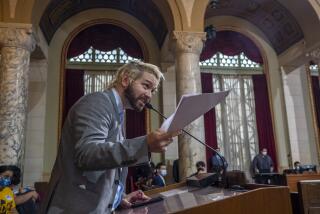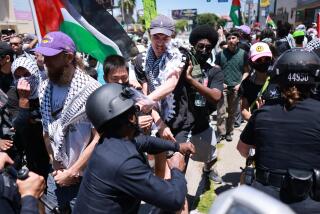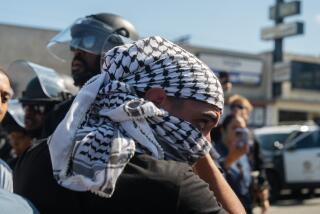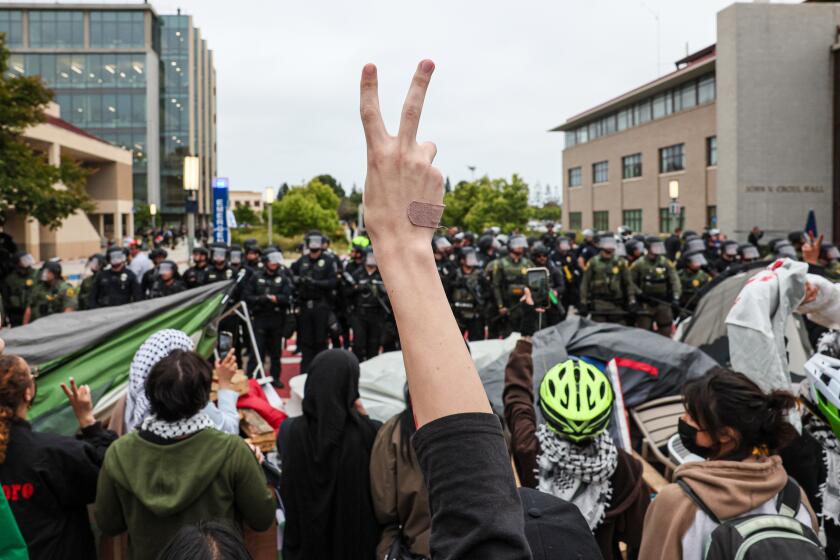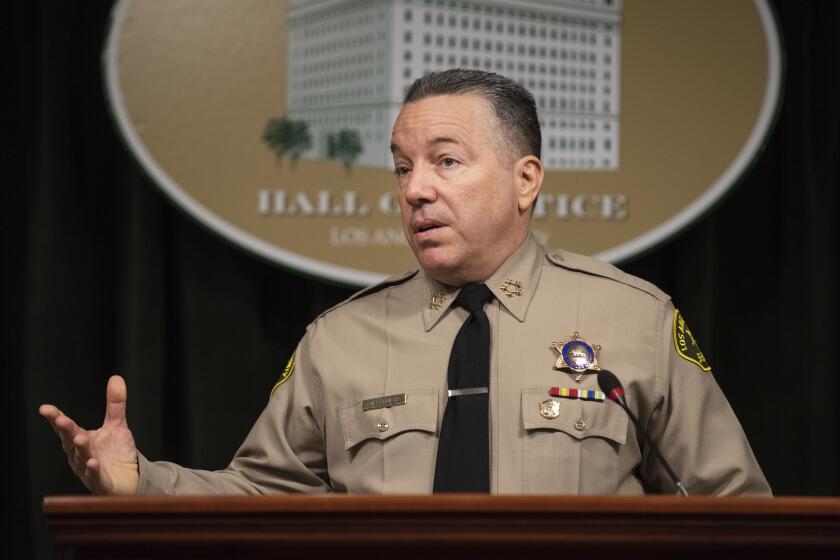May Day protests test LAPD
May Day rallies brought immigrant rights, labor and Occupy protesters onto Los Angeles streets Tuesday, snarling traffic and drawing a police force that at times outnumbered the demonstrators.
Only several hundred people heeded the call from organizers to gather for the annual May Day immigrant and labor-rights march, echoing a similarly poor turnout last year. The numbers were a far cry from previous years when tens of thousands or hundreds of thousands of marchers filled the streets to make Los Angeles the nation’s focal point in the debate over immigration.
The peaceful crowd marched up Broadway, through the heart of downtown, chanting familiar slogans of “Si, se puede!” and “No Justice, No peace,” while waving Mexican and American flags.
Meanwhile, after a winter largely out of the public eye, Occupy protesters used the day to try to reignite a movement that captured the country’s attention last fall, when people angry over unemployment, income inequality and Wall Street dissipation took over public spaces for weeks.
On Tuesday, about 1,000 of them converged downtown from various meeting points throughout the city, creating a chaotic and at times tense scene as many in the Occupy group squared off with the hundreds of police officers deployed throughout the streets.
Protesters, many of them concealing their faces with bandannas, and Los Angeles Police Department officers clad in riot gear engaged in a running game of cat and mouse, as the crowd tried in vain to make its way around police blockades to City Hall and police headquarters.
At dusk, a few hundred people regrouped several blocks south in Pershing Square for a meeting as police cruisers and a helicopter circled. The protesters had a city-issued permit to gather until 10 p.m.
Late Tuesday, the LAPD declared a citywide tactical alert, which allows the department to keep officers on duty past the end of their shift. Authorities would not say when they planned to disperse the crowd, but did say they would not allow the protest to continue all night. By 10:30 p.m., most of the protesters had left Pershing Square.
For the most part, police and protesters avoided any large-scale clashes, although at least one officer was injured when she was surrounded by a group of demonstrators and struck on the head with a skateboard. The impact dented the officer’s ballistic helmet, police said, and she was hospitalized in good condition.
By late evening, police reported at least 13 arrests: 10 demonstrators at Los Angeles International Airport who were protesting working conditions there and three downtown.
Nancy Evans, 62, of Venice said she came downtown to bring attention to the need to create jobs. A former animator who grew angry watching jobs being outsourced to other countries, she stood at 6th Street and Broadway with a contingent of Occupy protesters.
“I can see why people think this is very fragmented,” she said of the protests. “I thought there would be more of a focus on jobs.”
Skirmishes similar to the ones in Los Angeles played out in the Bay Area as well.
In San Francisco, a demonstration that started peacefully late Monday in Dolores Park ended with widespread vandalism as more than 100 masked protesters — dressed in black and gray and wielding crowbars and paintball guns — descended on a busy restaurant and retail stretch in the city’s Mission district. Vandals smashed windows, defaced cars and even attacked the neighborhood police station. In advance of a threatened strike by union workers, the Golden Gate Bridge, Highway and Transportation District shut down ferry service for the Tuesday morning commute.
In Oakland, police used tear gas and arrested at least nine people for failing to disperse and violating stay-away orders issued by a judge.
The clashes were in stark contrast to what many demonstrators said they sought to bring about by protesting: more rights for all people, peace and income equality, among other causes.
“I want to see a world where there is a whole different value system, where we actually put people before profits,” said Oakland protester Shaina Burnette, 31. “I would beg people who care about the future: It’s a movement, and you have to show up.”
That sentiment was echoed by many in Los Angeles, where demonstrators said they were disappointed by the meager number of people who came out.
Along with chilly temperatures and overcast skies, organizers were up against a political and social landscape that has changed since the massive outpouring of anger and frustration in past years.
For one, net migration from Mexico to the United States has come to a standstill as the number of people trying to cross the U.S.-Mexico border has fallen off and many immigrants have opted to return to their countries amid this country’s ongoing economic woes. Moreover, while immigration reform and deportation rules are still very pertinent issues, the battles are being fought more in courtrooms and legislative halls than in the streets.
“It’s gotten a lot smaller,” Jose Mata, 20, said of the May Day protests. His first May Day rally was in 2006, when hundreds of thousands of people flooded the streets.
“It was crazy to see so many people do something so empowering,” he said. “But I’m here to show people still care.”
Los Angeles Times staff writers Andrew Blankstein, Angel Jennings, Maria L. LaGanga, Kate Linthicum, Sam Quinones, Lee Romney and Matt Stevens contributed to this report.
More to Read
Sign up for Essential California
The most important California stories and recommendations in your inbox every morning.
You may occasionally receive promotional content from the Los Angeles Times.
